SS-Untersturmführer Heinrich Wicker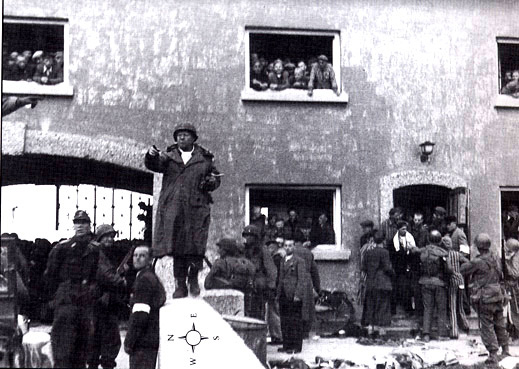 Late in the afternoon of April 29, 1945, KZ Dachau, the infamous Nazi concentration camp near Munich, was surrendered to the American Army by SS-Untersturmführer Heinrich Wicker, an officer in the SS-Totenkopfverbände. That morning, within the confines of the Dachau camp complex, Wicker had gotten together with his mother and sister who had arrived in Dachau to visit him on April 12, 1945. Wicker's fiance and her two-year-old son by Wicker were also there and were staying in the town of Dachau. After this last family get-together at the Dachau SS training camp on the morning of the surrender, Wicker's mother and sister never saw him again and they subsequently reported him to the International Tracing Service of the International Red Cross as a missing person. The photograph above shows 2nd Lt. Heinrich Wicker standing in front of the gatehouse into the Dachau camp after the camp was liberated. Brig. Gen. Henning Linden is standing on the bridge over the Würm river as he directs American soldiers who are trying to get the prisoners back inside the camp. In the months leading up to the surrender of the Dachau camp, Wicker had been carrying out other assignments, away from the main camp, and had only recently returned. From March 28, 1945 to April 2, 1945, Wicker had supervised the evacuation of prisoners from Neckarelz, a sub-camp of Natzweiler, to the Dachau main camp. In March 1945, the Mühldorf sub camp was evacuated and Martin Gottfried Weiss accompanied the prisoners to the main Dachau camp. Weiss had previously been the Commandant of Dachau from September 1942 to the end of October 1943 when he was transferred to the Majdanek camp. Between April 5 and April 15, 1945, Wicker had supervised the evacuation of around 1,700 prisoners from Hessental, another sub-camp of Natzweiler, to München-Allach, a sub-camp of Dachau. Allach was liberated by units of the 42nd Rainbow Division on the morning of April 30, 1945. At some point between April 15th and April 29th, Wicker was placed in charge of training "Kampfgrüppe Süd" (Combat Group South), a 250-man scratch unit formed from the guards who had formerly served at Neckarelz, Kochendorf and Hessental, all of which were sub-camps of Natzweiler. On April 26, 1945, Eduard Weiter, the last Commandant of Dachau, had left the camp with a transport of the prisoners who were being evacuated. For two days, Martin Gottfried Weiss was in charge of the camp before he left on April 28th along with most of the regular guards and administrators in the camp. On that same day, Victor Maurer, a representative of the Red Cross, had tried to persuade 1st Lt. Johannes Otto, the adjutant of Commandant Weiter, not to abandon the camp, but to leave guards posted to keep the prisoners inside until the Americans arrived. When Lt. Otto declined to remain in the camp, SS-Untersturmführer Wicker was then recruited by Maurer to accompany him to the main gate of the Dachau complex to formally surrender the concentration camp. There are many stories about the SS guards at Dachau being beaten to death by the prisoners after the liberation or shot with guns provided by the American liberators, and many accounts of the guards being summarily executed by the liberators after the surrender. Several American soldiers who arrived after the liberation reported seeing the mutilated bodies of German soldiers lying in the camp and near the "death train" outside the camp. No one knows if 2nd Lt. Wicker was among those who were brutally murdered that day. Since the day of the surrender, he has been missing, and is presumed dead. On 2 May 1945, Brig. Gen. Henning Linden sent a Memorandum to the Commanding General, which was his "Report on Surrender of Dachau Concentration Camp." In this report, Linden wrote that he had arrived in the town of Dachau at about 1500 hours or around 3 o'clock in the afternoon on the 29th of April. He had crossed the Amper river which flows through the town and then proceeded in the direction of the concentration camp where the first thing he saw was the Death Train. The photograph below shows the body of one of the prisoners on the train, which had left the Buchenwald concentration camp three weeks before, bringing evacuated prisoners to Dachau. 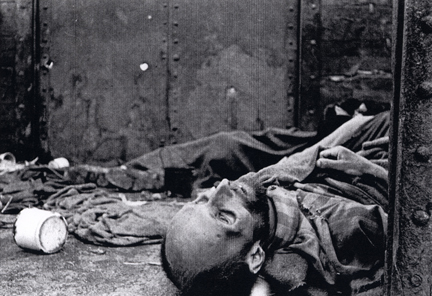 Linden wrote that he spent very little time looking at the train, but instead moved forward towards the camp, expecting to find Col. Donald E. Downard. Unknown to him at that point, Col. Downard had stopped to rescue a prisoner on the train who was still alive. The following quote is from Brig. Gen. Linden's Report: As we moved down along the west side of the concentration camp and approached the southwest corner, three people approached down the road under a flag of truce. We met these people about 75 yards north of the southwest entrance to the camp. These three people were a Swiss Red Cross representative and two SS troopers who said they were the camp commander and assistant camp commander and that they had come into the camp on the night of the 28th to take over from the regular camp personnel for the purpose of turning the camp over to the advancing Americans. The Swiss Red Cross representative acted as interpreter and stated that there were about 100 SS guards in the camp who had their arms stacked except for the people in the tower. He said he had given instructions that there would be no shots fired and that it would take about 50 men to relieve the guards, as there were 42,000 half-crazed prisoners of war in the camp, many of them typhus infected. He asked if I were an officer of the American army, to which I replied, "Yes, I am Assistant Division Commander of the 42d Division and will accept the surrender of the camp in the name of the Rainbow Division for the American army." As we were talking there were several rifle shots fired over in the northwest corner of the camp, and when I asked the representative about the firing he said he knew nothing about it and could only state that he had given strict instructions that there would be no shooting. The northwest corner of the camp, from which Linden hear rifle fire, was where the greenhouse was located. Just outside the northwest corner of the prison enclosure was the crematorium where the gas chamber was located. The 45th Division had already arrived at the Dachau camp complex shortly before, and were inside the SS training camp where the Waffen-SS soldiers who were stationed there had also surrendered under a white flag of truce, but were being gunned down by the Americans. Neither Brig. Gen. Linden, nor Victor Maurer, the Red Cross Representative, mentioned anything in their reports about what happened to 2nd Lt. Wicker or his aide after they surrendered the camp. The photograph below shows 2nd Lt. Wicker, in front of the death train; he is standing next to Victor Maurer, who is wearing a white armband. Wicker is the third man from the left. The second photograph below was contributed by Donald E. Jackson, who was with the 40th Combat Engineer Regiment at the Dachau liberation. Jackson believes that this is a photo of the "commander of the camp." It shows a tall, slender SS soldier, wearing the same style of uniform as that worn by 2nd Lt. Wicker, lying on the ground after he was killed. The second photo is shown first in vertical format, so that the viewer can compare it with the first photo, and then in horizontal format, the way it was taken. 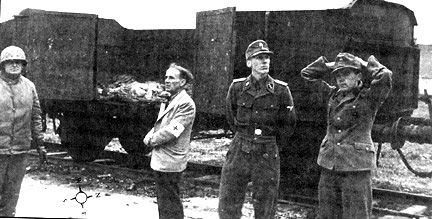 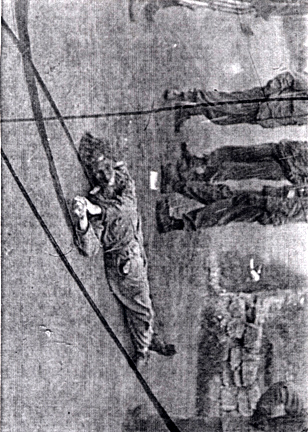 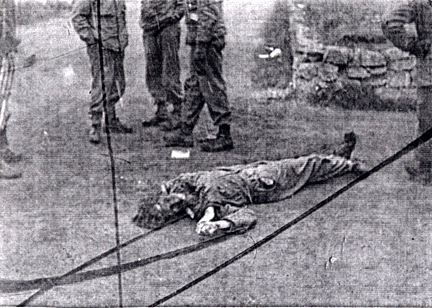 In the photograph immediately above, notice a man on the extreme left wearing a striped prison uniform, and four US soldiers in the background. The liberated prisoners were allowed to participate in the killing of the SS men. The dead man has his hands clasped together, as though he were holding something just before he died. After the liberation of Dachau, Lt. Col. Joseph M. Whitaker of the Office of the Inspector General of the Headquarters of the Seventh Army conducted an investigation of the slaughter of the German soldiers who had surrendered. He filed a SECRET report on 8 June 1945, which has since been made public and is included in the Appendix of a book written by Col. John H. Linden, the son of Brig. Gen. Henning Linden who accepted the surrender of the camp. The following quotations are from Whitaker's report: 14. After the camp was taken and was somewhat settled down, two Germans were shot by inmates who used the service rifle of Pfc Peter J. De Marzo, 42175967, Company "L", 157th Infantry, 45th Division, who was then on guard duty. Although his company commander, Lt. Lawrence R. Steward, Jr, 0-1060658, was informed of such a happening, no investigation has been made in the company to determine the facts or whether or not such soldier or other members of the guard should receive disciplinary action. (12) IV. RECOMMENDATIONS 32. In view of the transfer of the 42d and the 45th Divisions, it is recommended that this report be forwarded to the Commanding General, Third Army, for such action as he may deem appropriate. The Commanding General of the Third Army was General George S. Patton. The action that he deemed appropriate was to tear up the court-martial papers for Pfc. De Marzo and all the other American soldiers who were involved in killing the German guards. None of the Americans who committed murder on the day of the liberation, or who stood by while the inmates killed the guards, using American weapons, were ever punished for their actions. Lt. Col. Whitaker's report also included the following: 17. The bodies of the dead Germans in two instances showed severed finger, in other instances crushed skulls. There is no evidence that the SS men were mutilated before they were shot. The names of the two German guards who were shot by the inmates with an American weapon were not in the report of the investigation. The names of the two dead Germans who were mutilated are likewise unknown. Heinrich Wicker was born on June 30, 1921 at Gausbach bei Gernsbach in Baden-Württemberg. On September 9, 1933, at the age of 12, he joined the Deutsches Jungvolk in der Hitler-Jugend. Although he was only 24 years old at the time that he accepted the responsibility of surrendering the Dachau camp, Wicker was already a veteran with 8 years of service in the elite SS. He had enlisted in the SS-Totenkopfverbände on June 25, 1937, five days before his 16th birthday. On November 1, 1938, at the age of 17, Wicker was sent to Dachau which had a military garrison with a training camp adjacent to the concentration camp. At that time, Wicker was an SS-Sturmmann in the SS-Totenkopf Standarte 1 Oberbayern, a Waffen-SS outfit. As a Waffen-SS soldier, Wicker fought in combat during the German invasion of France, the Netherlands, and Belgium between May 17 and June 25, 1940 as a member of the SS Totenkopf Division. His division then participated in the invasion of the Soviet Union in June 1941. On February 13, 1942, Wicker was badly wounded by a bullet to the jaw near the town of Gusi. He was evacuated from the front the next day and spent a year recovering from his injury. On February 13, 1943, he was declared fit for non-combat duty and was assigned to Ersatz Battalion der Freiwilligen Legion Neiderlande" (Netherlands Volunteer Legion Replacement Battalion) stationed at Graz, Austria. On May 1, 1943, this battalion was inactivated and Wicker was assigned to 11. SS AuE Abt. (11th Armored Infantry Division's Training & Replacement Battalion) also stationed at Graz. From August 3, 1943 to November 24, 1943, Wicker was in training at the Officer Candidate School at Bad Tölz. After successfully completing the officer training course for disabled soldiers, Wicker was assigned to Amtsgruppe D des SS-Wirtschafts-Verwaltungshauptamt in Berlin-Oranienburg with the rank of SS-Oberscharführer. Amtsgruppe D of the SS-WHVA was the concentration camp branch of the SS Economic and Administrative Main Office. By January 30, 1944, Wicker had completed his two-month probationary period with Amt D of the WVHA, and he was promoted to SS-Untersturmführer, a rank equivalent to a 2nd Lt. in the U.S. Army. On July 1, 1944, Wicker was transferred to KZ Natzweiler-Struthof, a concentration camp in Alsace, which at that time was in the Greater German Reich. He was an administrator in the camp with the grade of SS-Untersturmführer. From July 1944 to September 15, 1944, he was assigned to duty at Kochem, a sub-camp of Natzweiler. Between September 16, 1944 and December 1944, Wicker's whereabouts are unknown, but in December 1944, he was assigned to be the last commander of Mannheim-Sandhofen, another sub-camp of Natzweiler-Struthof. Until recently, the man who surrendered the Dachau camp was known only as Lt. Wickert, the name that Victor Maurer put in his report to the Red Cross. Maurer did not know the man's first name, nor if he had survived the bloody liberation of the camp. I am indebted to Art Lee who sent me most of the information above. Mr. Lee's source for the biographical information was the form completed by Wicker when he was posted to Dachau on November 1, 1938, which Mr. Lee received from Paul Martin of the House of Bavarian History in Augsburg. Mr. Martin's source was a document in the Bundesarchiv in Berlin. The information about Wicker's family visit was sent to me by Art Lee who quoted a five-page document written by Peter Koppenhoefer. According to Koppenhoefer, two of the SS guards who survived the Dachau massacre told a team of investigators that American soldiers had taken 2nd Lt. Wicker into a building and shot him. Koppenhoefer got much of his information from a man named Stahl, who had been one of the guards in Tower G on the day of the liberation. An account of the surrender of Dachau is contained in a book by Col. John H. Linden entitled "Surrender of the Dachau Concentration Camp, 29 Apr 45; The True Account." Col. Linden is the son of Brig. Gen. Henning Linden who accepted the surrender of the camp. In his book, Col. Linden identified the man who surrendered the camp as Lt. Wickert since this is the name that Victor Maurer wrote in his report. Col. Linden's book now has an addition to the Appendix in which the name is corrected as SS 2nd Lt. Heinrich Wicker. The updated information for Appendix D-1 in Col. Linden's book came from the German Service Center for the Notification of the Next of Kin of the Fallen of the former German Armed Forces in Berlin, which provided the data to Dr. Juergen Zarusky, a staff member of the Institute of Contemporary History in Munich. Dr. Zarusky wrote an article which included the biographical data on Wicker, which was published in the December 1997 Dachau Memorial Museum publication entitled "Dachauer Hefte Nr. 13". Dr. Zarusky's article was translated from German to English by Pierre C.T. Verheye, Buchenwald Prisoner No. 126637. The article reported for the first time the positive identification, by the German Service Center, of Heinrich Wicker as the SS 2nd Lt. who surrendered the Dachau Concentration Camp to Brig. Gen. Henning Linden, Assistant Division Commander, 42nd Infantry Division on April 29, 1945. If not for 2nd Lt. Wicker's heroic act in accepting responsibility for surrendering the Dachau camp to the American Army, the liberation of Dachau could have been even more of a bloody disaster than it was. The Commandant and the regular guards had abandoned the camp the day before, and if Wicker had not stayed behind to post his group as replacement guards to keep the prisoners inside until the Americans arrived to take charge, there might have been even more carnage with the prisoners roaming the countryside and taking revenge on innocent German citizens. According to Peter Koppenhoefer, a German historian, Wicker's parents had to undergo the Allied "denazification" process after the war, but they were able to conceal their son's concentration camp activity as well as the duties that he had performed in the evacuation marches, which would have automatically made him a war criminal. His mother denied that she had seen her son at Dachau on the morning of the day he was killed, and instead claimed that she had last seen her son in January 1945. As the family of a Waffen-SS soldier, the parents received a pension from the German government from 1951 to 1959. Wicker's son, born out of wedlock in March 1943, received an orphan's pension. In order to receive these pensions, Wicker would have had to have been declared dead. If Wicker had not been killed during the liberation of Dachau, he would have been immediately arrested by the American liberators, and he would have been incarcerated as a war criminal in the Dachau concentration camp, along with 30,000 other SS soldiers, as soon as the former concentration camp prisoners were released in June 1945. As a member of the staff of a concentration camp, he would have been automatically considered a war criminal because he had participated in the Common Plan of the Nazis to commit war crimes. The Nazi concentration system was designated as a criminal enterprise by the Allies, which meant that all concentration camp staff members, in whatever capacity, were automatically war criminals. If Wicker had lived, and if he had not been selected as one of the Dachau staff members to be put on trial by an American Military Tribunal in November 1945 in one of the buildings in the Dachau complex, he would have remained a prisoner in the former Dachau concentration camp until 1948 when America became allies with West Germany. At that time, he would probably have been turned over to the French government for trial as a war criminal because of the time he had spent as an administrator in the Natzweiler camp in Alsace. After the war, Alsace had become part of France again. For his part in administering the Natzweiler camp and supervising the evacuation of the sub-camps of Natzweiler, Wicker would probably have received a life sentence in a French prison, although he would most likely have been released after about 10 years. If Wicker had lived, his family might have been incarcerated in one of the former Nazi concentration camps, along with the other families of the German war criminals. Some of the bodies of the SS soldiers who were killed during the liberation of Dachau are believed to have been buried on the grounds of the SS garrison. Other bodies were burned in the crematorium at Dachau. Click on the link below to see a photo which is believed to show the body of Heinrich Wicker in the morgue next to the crematorium. PreviousArticle about Heinrich Wicker in GermanThe Body of 2nd Lt. Heinrich Wicker in the morgueBack to Liberation of DachauBack to Table of ContentsHomeThis page was last updated on November 7, 2007 |